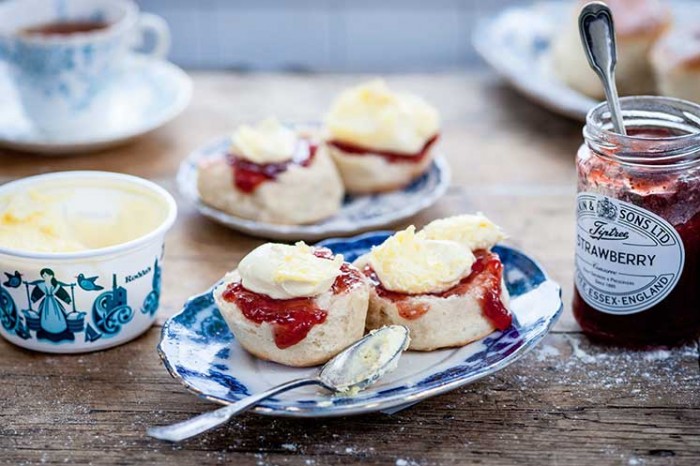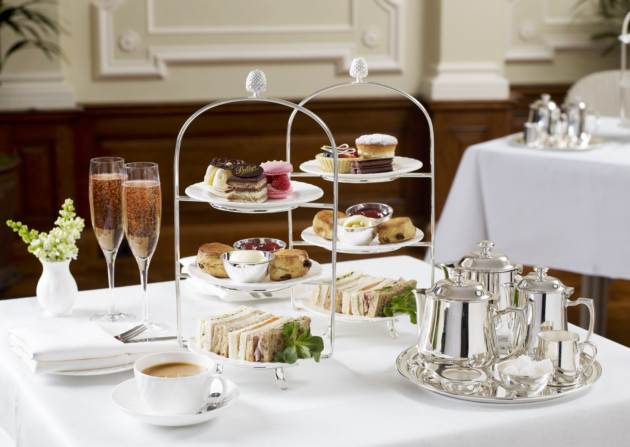Celebrate National Cream Tea Day
The jam must be strawberry and the cream always clotted, dolloped on a crumbly scone and accompanied by a perfectly brewed cup of tea
We don’t really need an excuse to indulge in a delightful Cream Tea but the Cream Tea Society and Rodda‘s have given us one anyway, as today is National Cream Tea Day, a chance to celebrate the quintessentially British treat and raise money for charity at the same time.
Britain’s love affair with tea began when Portuguese Catherine de Braganza married Charles II in 1662, bringing tea-drinking to court. The fashion exploded, particular after 1706, when Thomas Twining opened London’s first tearoom, which was far more inviting for a lady than the male-oriented coffee houses.
But we have the Duchess of Bedford to thank for the invention of afternoon tea proper. What began as ordering tea and treats to her room when peckish in the afternoon, soon evolved into a full-blown social affair, inviting friends to join her in her country house. By the middle of the 19th century, afternoon tea – a spread of sandwiches, cakes, scones, cream and jam (the first hint of cream teas as we know them today) were a daily occurrence up and down the country.
The tradition of cream tea associated with the Westcountry flourished following the tourism boom in the 1850s, sparked by the opening of the railway. Visitors who headed south for sun and sea air still wanted their treats and soon delicious afternoon cream teas, made with the finest local ingredients, were being offered up and enjoyed with delight.
So, is it cream then jam, or jam then cream? The answer’s in the difference between the Cornish and the Devonshire cream tea, and the cause of much controversy, although etiquette gurus Debrett’s say you should spread your jam before dolloping cream on top. But one thing is universal: never use whipped cream. It’s utterly improper – stick with clotted.
Find out more about where you can find the best Cream Teas around the UK and how go get involved with National Cream Tea Day at the Cream Tea Society’s website.
Quintessential Scones
These scones not only have clotted cream served on them, but incorporated into them too. Light, fluffy and extra special to create as well as eat, they are a new take on the quintessentially British cream tea component.
INGREDIENTS
300g self-raising flour, plus extra for dusting and dipping
1 tsp baking powder
50g Rodda’s butter, cut into pieces
50g Rodda’s clotted cream – use the crust and top layer from a 227g pot
50g caster sugar
150ml whole milk
Remaining Rodda’s clotted cream and butter together with a jar of Tiptree jam
METHOD
Heat oven to 220C/fan 200C/gas 7
Sift the flour and baking powder into a large bowl.
Rub the butter into the flour in the big bowl with your fingertips to create a fine breadcrumb mixture. Remove the crust of the clotted cream and some of the firmer top layer beneath it to make up the 50g required and dollop it into the breadcrumb mixture in clumps. Rub this into the breadcrumb mixture in the same fashion as done with the butter.
Add in the sugar and toss through with your hands, spatula or spoon to combine everything together.
Make a well in the middle of the mixture in the bowl and add the milk, saving a little bit back to paint the top of the scones with. Fold through lightly put firmly with a spatula or spoon until the mixture comes together.
Sift some flour onto a work surface and your hands. Use your hand to lightly knead and bring the dough together and pick up any dry bits of flour from the base and sides of the bowl before tipping it out onto the floured surface.
Pat or roll out the dough with a rolling pin to approximately 2.5cm deep.
Leave to sit for a few minutes while you cut out some non-stick parchment paper and line a flat baking tray.
Take a 5cm plain circular cutter and dip in some flour sat in a bowl to help prevent the cutter sticking to the dough. Press firmly into the rested dough, try not to twist the cutter but pick up and gently press out the dough on to the prepared baking sheet.
Repeat until you have cut as many as you can and then gently knead together the remaining dough and re-pat or roll. You are ideally looking at cutting out 10 scones in total.
Brush the top of the scones with the remaining milk and bake near the top of the pre-heated oven for approximately 10-15 minutes until risen and lightly golden brown.
Once baked and allowed to cool slightly slice into two and serve with a dollop of jam and remaining clotted cream.





